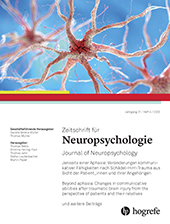Abstract
Zusammenfassung. Kommunikationsstörungen nach erworbenen Hirnschädigungen ohne Aphasie werden trotz ihrer Bedeutung für die Rehabilitation häufig übersehen. Wir baten 52 Patient_innen nach Schädel-Hirn-Trauma (SHT) und ihre Angehörigen um die direkte Einschätzung von Veränderungen kommunikativer Fähigkeiten und daraus resultierender Beeinträchtigungen. Betroffene und Angehörige erlebten vergleichbar relevante Verschlechterungen und Alltagsbeeinträchtigungen. Wir ermittelten die konsistente Kern-Symptomatik und fanden faktorenanalytisch fünf Dimensionen Kognitiver Kommunikationsstörungen. Entgegen der Annahme einer Bedeutung von Exekutivfunktionen bestanden lediglich moderate Korrelationen zu Gedächtnis- und Aufmerksamkeitsleistungen. Neuropsychologische Störungen und die psychische Belastung erklärten Veränderungen der Kommunikation nicht hinreichend. Analysen zur Bedeutung diffuser axonaler Schädigungen oder Kontusionsverletzungen werden diskutiert. Unsere Befunde unterstützen die Notwendigkeit einer Diagnostik und Behandlung Kognitiver Kommunikationsstörungen als eigenständiges Konzept. Die Daten werden zur Weiterentwicklung eines praktikablen Veränderungsfragebogens genutzt.
Abstract. Communication disorders following acquired brain damage without aphasia are often overlooked despite their importance for rehabilitation. We invited 52 patients with traumatic brain injury (TBI) and their relatives to directly assess changes in communicative abilities and the resulting impairment. Patients and relatives experienced a similar decline and impairment in communication. We discovered consistent core symptoms and found 5 dimensions using factor analysis. Contrary to the assumption of the importance of executive functions, there were only moderate correlations to memory and attention performance. The significance of diffuse axonal damage or contusion injuries is discussed. Our findings support the need for a diagnosis and treatment of cognitive communication disorders as an independent concept. Data will be used for the development of a practicable change questionnaire.
Literatur
(1995).
Language, communication, and the right hemisphere . In H. S. Kirshner (Ed.), Handbook of neurological speech and language disorders (pp. 325–348). New York: Marcel Dekker.(2006). Einführung in die Test- und Fragebogenkonstruktion. München: Pearson Studium.
(2014). Sprache und Kognition. Diskurspragmatik und Textverarbeitung bei Exekutivstörungen. Tübingen: Stauffenburg.
(2019). Kognitive Kommunikationsstörungen (Fortschritte der Neuropsychologie, Bd. 19.). Göttingen: Hogrefe.
(2005). Nonstandardized assessment approaches for individuals with traumatic brain injuries. Seminars in Speech and Language, 4, 223–241.
College of Audiologists and Speech-Language Pathologists of Ontario . (2002). Preferred practice guidelines for cognitive-communication disorders. Ontario: College of Audiologists and Speech-Language Pathologists of Ontario.(2009). Clinical pragmatics. Cambridge: Cambridge University Press.
(2010a). Using the La Trobe Communication Questionnaire to mesure perceived social communication ability in adolescents with traumatic brain injury. Brain Impairment, 11, 171–182.
(2010b). Relation of executive functioning to pragmatic outcome following severe traumatic brain injury. Journal of Speech, Language, and Hearing Research, 53, 365–382.
(2000). Measuring perception of communicative ability: The development and evaluation of the La Trobe Communication Questionnaire. Aphasiology, 14, 251–268.
(2008). The extended language network: A meta-analysis of neuroimaging studies on text comprehension. Human Brain Mapping, 29, 581–593.
(2002). SCL-90-R – Die Symptom-Checkliste von L. R. Derogatis (2. Aufl.). Göttingen: Beltz Test.
(2017). Apathy and cognitive deficits in patients with transient global ischemia after cardiac arrest. Cognitive and Behavioral Neurology, 30, 172–175.
(1995). Kommunikationsstörungen bei Patienten mit Frontalhirnläsionen. Sprache – Stimme – Gehör, 19, 1–7.
(1990).
The assessment of functional communication . In D. E. Tupper & K. D. cicerone (eds.), the neuropsychology of everyday life: assessment and basic Competencies (pp. 125–168). Boston: Kluver Academic Publishers.(2006). Kognitive Dysphasien. Differenzialdiagnostik aphasischer und nichtaphasischer zentraler Sprachstörungen sowie therapeutische Konsequenzen. Frankfurt am Main: Peter Lang.
(2004). A meta-analytic review of verbal fluency performance in patients with traumatic brain injury. Neuropsychology, 18, 621–628.
(2010). Das Verstehen von emotionalen und zeitlichen Aspekten des Situationsmodells: Defizite von Patienten mit frontaler Hirnschädigung. Neurolinguistik, 24, 25–50.
(1987).
Regulatory function of the frontal lobes . In E. Perecman (Ed.), The frontal lobes revisited (pp. 225–240). Hillsdale: Erlbaum.(2002). Kommunikationsschwierigkeiten nach Schädel-Hirn-Trauma: Entwicklung eines Fragebogens für Patienten und Angehörige. Diplomarbeit, Universität Würzburg.
(1996). The Profile of Functional Impairment in Communication (PFIC): A measure of communication impairment for clinical use. Brain Injury, 10, 397–412.
(2004). The neuropsychology of narrative: Story comprehension, story production and their interrelation. Neuropsychologia, 42, 1414–1434.
(2016). Communication disorders following traumatic brain injury. London: Taylor & Francis Ltd.
(2013).
Gedächtnis . In F. Schneider & G. R. Fink (Hrsg.), Funktionelle MRT in Psychiatrie und Neurologie (S. 393–407). Berlin: Springer.(2004). Neuropsychologische Rehabilitation. Berlin: Springer.
(1985). Nonaphasic language disturbances after brain injury. Language Sciences, 7, 217–229.
(2017). Kognitive Kommunikationsstörungen in der Sprachtherapie und der Neuropsychologie. Aphasie und verwandte Gebiete, 1, 16–30.
(2006). Cognitive sequelae of diffuse axonal injury. Archives of Neurology, 63, 418–424.
(2014).
Veränderungsmessung, direkte . In M. A. Wirtz (Hrsg.), Dorsch – Lexikon der Psychologie (S. 1617). Bern: Hogrefe.(2008). Perceptions of communication abilities for persons with traumatic brain injury: Validity of the La Trobe Communication Questionnaire. Brain Injury, 22, 940–951.
(2014). INCOG recommendations for management of cognition following traumatic brain injury, part IV: Cognitive communication. Journal of Head Trauma Rehabilitation, 29, 353–368.
(2015). Evaluation of regional white matter volume reduction after diffuse axonal injury using voxel-based morphometry. Magnetic Resonance in Medical Sciences, 14, 183–192.



